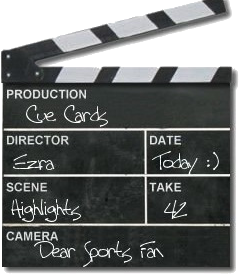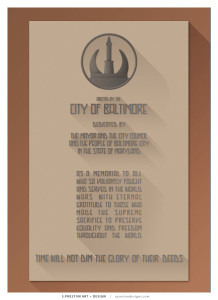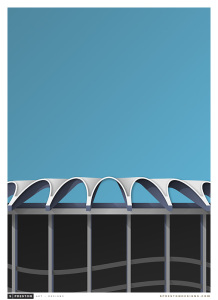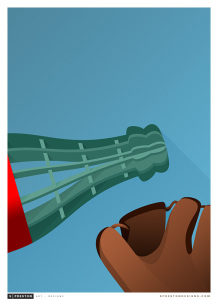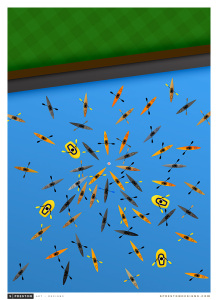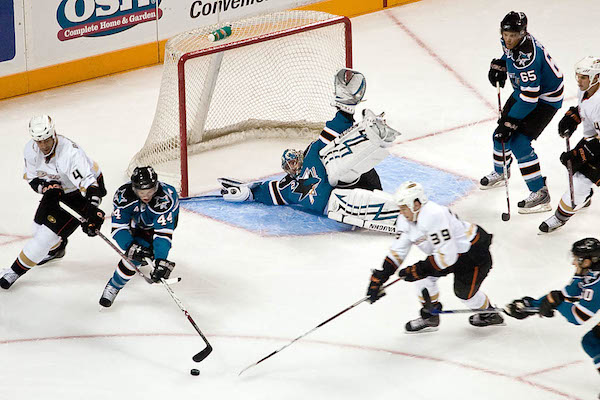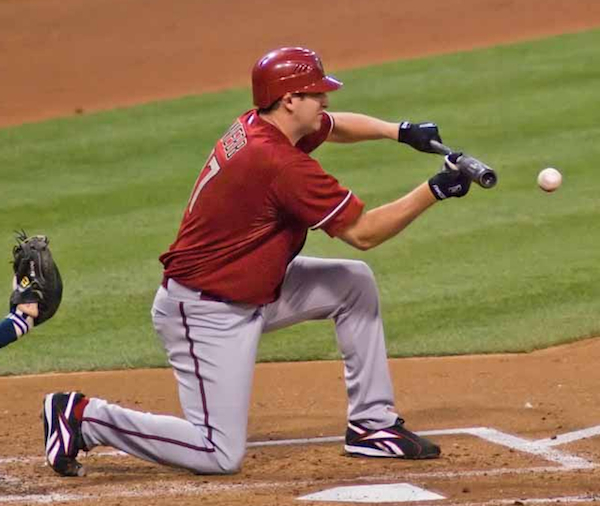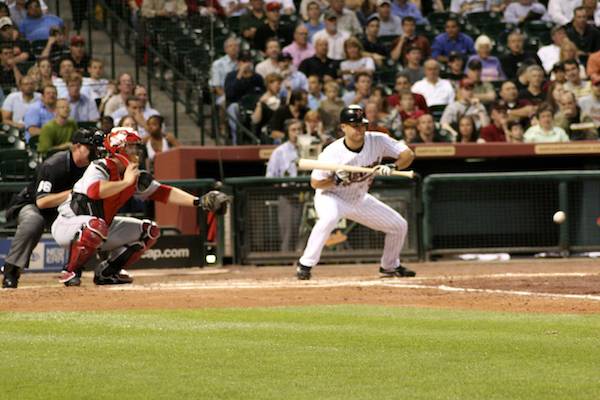- Cardinals walk off with a homer and a win — The St. Louis Cardinals won the second game of their best-four-out-of-seven series 5-4 against the San Francisco Giants on a walk-off home run in the bottom of the ninth inning. The game was close throughout but Cardinals fans had to be fearing the worst when the Giants tied the game in the top of the ninth inning. Their fear of losing a second straight game to the Giants was ameliorated when Kolten Wong blasted the ball 370 feet and out of the ballpark.
Line: The line between being down two games to zero and being tied one to one is so thin.
What’s Next: Game three is on Fox Sports 1 at 4:00 Tuesday, October 14. - Fascinating day, boring night in the NFL — There were gobs of excellent football games yesterday. The Panthers and Bengals played to an unusual 37-37 tie. The Packers eeked by the Dolphins on a late touchdown drive. The Titans hit a last second field goal to keep the Jaguars winless for the season. The Chargers sneaked by the unexpectedly feisty Raiders. The day’s titanic game between the Cowboys and Seahawks lived up to expectations. But the prime-time game between the Giants and Eagles was b-o-r-i-n-g! Brush up on all the games with our Week Six NFL One Liners.
Line: The NFL was exciting all day but then it turned into a pumpkin at night.
Tag: baseball
News Clippings: Sunday, October 12
One of my favorite parts of writing Dear Sports Fan is reading other great writers cover sports in a way that’s accessible and compelling for the whole spectrum from super-fans to lay people. Here are selections from some of the articles this week that inspired me.
This article profiles former NBA player Keyon Dooling and his life long struggle to come to terms with and recover from being abused as a child. It’s a fascinating and eventually uplifting piece that reminds us that no matter how big, strong, and fearless athletes look when they’re on stage, they are real people with their own struggles.
Keyon Dooling’s Secret
By Jordan Ritter Conn for Grantland
Now, when Dooling looks back on those years, he sees how he tried to cope with the trauma of his past. He sees himself in fourth grade, sneaking to his father’s liquor cabinet, pouring himself strong drinks and sipping them until the world was gone. He sees himself in middle school, smoking weed with friends, letting the drug ease the anxiety he’d felt since that afternoon. He sees himself at that same age, flirting with girls and then taking them home. The more girls he slept with, he thought, the more he proved that he was no longer that little boy.
Basketball helped. On the court, he could assert his dominance. With the ball in his hands, he never felt like a victim. He loved the power his talent gave him, the confidence that grew from knowing that almost every kid in his school and his neighborhood could only dream of doing what he could do on a hardwood floor. The first time he dunked — as a freshman, in a game — he felt invincible. As he grew older, the memory of that afternoon faded, but the coping strategies remained.
This past week, I reblogged a piece about how baseball fans need to decide — do they want a clean game or an exciting game. This triggered a back and forth with a baseball fan and friend of Dear Sports Fan who sent me this well-written piece as a rebuttal. I have to admit, after reading this defense of the pace of baseball, I question how much of my attitudes towards the sport are the product of hearing other people’s cliched criticism.
What Pace of Game Problem?
By Russell Carleton for Fox Sports
Allowing for the fact that some of the rule changes would spawn some workarounds, you might save 20 minutes off the average game. All it would cost you is the clock-less-ness of baseball, the idea of free substitution, and a small piece of the integrity of the game. In other words, baseball would become a different game and for not much benefit.
What I find interesting is that baseball seems to have a pace of game problem because everyone says that it does… Maybe it’s just time that baseball recognized that there are people out there who enjoy a slower game and stopped trying to be all things to all people… Baseball should simply embrace the fact that it is a slower game and market itself accordingly. It’s a feature, not a bug. There’s no pace of game problem because there’s nothing morally superior about playing rushed games that take two and a half hours instead of three, no matter what United States culture tries to say.
This essay grapples with the difficulty of producing accurate statistics comparing NFL players to… well, to who, exactly? That’s part of the problem. With all of the scary statistics flying around about the health effects of playing professional football, it’s very hard to know what is real and what isn’t. I hope someone can take the work of this charmingly skeptical article and do the hard work to produce more reasonable and accurate scientific studies. There’s undeniably something scary happening to some percent of pro football players. Let’s figure it out.
NFL Players Die Young. Or Maybe They Live Long Lives.
By Daniel Engber for Slate
For every 770 men who play the sport on a professional level, we can expect one extra death from ALS. (Extra deaths from Alzheimer’s are even more unusual.)
Any extra death is cause for grave concern, but if you look at other, much more common deadly conditions, the change in risk goes the other way. The same dataset suggests that for every 770 football retirees, we should expect 13 fewer deaths from cardiovascular disease and 14 fewer from cancer. So while it’s true that Alzheimer’s and ALS rates among NFL athletes could reasonably be described as “through the roof,” the number of players’ lives saved from heart disease and cancer exceeds the number of lives lost to those diseases by 2,150 percent.
But the methods used to find these stats raise a familiar and important question: Should football players really be compared to average men their age, of any race or body size or income level? How much does the choice of analysis affect its outcome?
So is it better to control for income or race, or should studies strive for both? And what about body size?
These may sound like simple questions, but they’re exceedingly difficult to answer. To some extent, the best approach depends on how you think about the NFL, and what point you’d like to make.
This charming story about the financial plight of the Haiti and Trinidad and Tobago women’s national soccer teams reminds us that not all athletes have financial support on NFL levels. Sometimes it takes a desperate tweet and a kind opponent to get things started so that the Clinton foundation can finish things up!
Haiti pledges money to Trinidad and Tobago soccer
By Kurt Voigt and Anne M. Peterson for the Associated Press
Upon getting word that the Trinidad and Tobago women’s national soccer team might not even have enough money for lunch, Haiti’s team took a look at its fundraising for World Cup qualifying — an account totaling a little over $1,300 — and decided to turn it over to the competition.
Between a rock and a needle
This article about baseball made me smile. It’s spot on and it has implications across sports. In baseball, amphetamines and then steroids made the game more compelling for fans. In cycling it was the dominance of Lance Armstrong aided by sophisticated blood doping. The violent collisions are a big part of why people like football but they come at a severe cost to the long-term health of some players. What is the right balance between clean and compelling? How can leagues navigate their way towards a healthy equilibrium?
Fans Sick of the Steroid Era Shouldn’t Complain Now
by William Rhoden for the New York Times
“You can’t have it both ways,” I said, pointing to the television screen as another batter grounded out. “You can’t tell baseball to get rid of steroids, rage again at so-called steroid cheats, and then complain when you get this.”
Baseball’s conundrum is how to present a clean game, and a quicker one, too, for that matter, that can attract more young fans. Nine-inning games that last nearly four hours are not the answer.
As to whether baseball is a sounder game now than it was when balls were flying out of the park not long ago — that’s a matter of taste.
Beautiful Baseball Stadium Prints
With four teams left alive in the baseball playoffs, fans of the San Francisco Giants, the St. Louis Cardinals, the Baltimore Orioles, and the Kansas City Royals are freaking out about their teams with good reason. Making the semifinals (called the American League Championship Series and the National League Championship Series) is an achievement in and of itself. For fans of the Orioles and Royals in particular, this year will be one to remember for a long time. One of those teams (they play each other) will make it to the World Series after only making the playoffs once since 1997 (Baltimore) or not at all since 1985 (Kansas City.) If you live with a fan of one of these teams, you might want to invest in one of these wonderful minimalist baseball stadium prints by S. Preston. Not only are they great presents but they’re also a good defense against your fan buying a regular sports poster to remember the season by; one that you will not want hung in your living room. A gift of one of these prints says, “I like how big of a fan you are and I support your team” without saying “let’s turn our house into a locker room.”
S. Preston is a “graphic designer and digital artist, born and raised in Canada, now living in sunny California.” These prints are a side project for him but an extremely successful one. As I think you’ll see from looking at his work, he’s a super talented artist. In his minimalist stadium series, he identifies one signature element of a stadium and designs a beautiful version of it. All of the prints are available for sale on his site in a number of different sizes and configurations. Particularly cool is the option to have the stadium name, city, and the date it was built excluded from the design. If you choose this option, you’re left with a striking, colorful representation of your or your fan’s favorite stadium without any words on it to clue in the uninitiated. Here are links to and samples of the prints for the four remaining teams in the playoffs. Follow this link to S. Preston’s website if you’d like to check out any other stadiums.
Kansas City Royals – Kaufman Stadium
The Royals are my favorite team remaining. They’ve lost forever and now that they’re good, they bunt constantly. It’s fitting that this is one of my favorite of S. Preston’s prints. I love how this print immediately makes you think of the Royals without showing a baseball, glove, bat, field, or anything.
Baltimore Orioles – Camden Yards and Memorial Stadium
The Orioles are my second choice to win the World Series if the Royals can’t do it. They’re a bright, vibrant team from another long-suffering city. S. Preston not only creates visuals of current stadiums but also of some great stadiums that are no longer in use. Baltimore’s Memorial Stadium, demolished in 2002, is one of the stadiums that got S. Preston’s retro minimalist treatment. I have to say, I love the Camden Yards one — it shows just the B&O Railroad warehouse that sits behind the outfield of the stadium and still, you can tell what he’s getting at.

St. Louis Cardinals – Busch Stadium and Busch Memorial Stadium
St. Louis is one of the most successful baseball franchises and I’ve heard that it’s a more crazed baseball city than any in the country. If so, the city’s living rooms should be full of these prints. Both prints are great — the modern one identifies itself by the St. Louis arch mowed into the outfield. The vintage print shows the sky, the upper deck, and some very cool architecture on the roof.
San Francisco Giants – AT&T Park
If you only know one baseball stadium, you probably know Boston’s Fenway park because of its signature Green Monster wall looming over left field. If you only know two, you probably know Fenway Park and Chicago’s Wrigley Field with its classic brick walls covered with ivy. If you know three though, you probably know San Francisco’s AT&T Park because you probably saw it on the news when Barry Bonds was busy smashing balls over the wall and into McCovey Cove where lunatics in kayaks waited to grab them. That image is the one S. Preston chose in his second (and the only one still for sale) design of AT&T Park.
Why is the start of a season in sports so exciting?
Dear Sports Fan,
Sports seasons are so long — how can anyone get excited at the very start? It’s going to be at least six months until the playoffs in most sports.
Thanks,
Jan
— — —
Dear Jan,
The start of a season is exciting for many reasons and only a few of them have to do with making the playoffs. You’re absolutely right about how long sports seasons are. Take the National Hockey League (NHL) which is starting tonight. The NHL regular season is 82 games. It starts in early October and ends in mid-April. That’s a long, long time and a lot of games! The National Basketball Association plays the same number of games. Baseball plays 162 or roughly twice the number. Football is the outlier here with relatively short seasons — 16 games in the National Football League and around 12 for college teams. Setting football aside, the first few games for a baseball, basketball, or hockey team don’t actually mean very much in terms of their eventual record and qualification for the playoffs. A fan’s excitement for and enjoyment of the start of the season can’t be measured in wins and losses but it can be described. Let’s give it a shot.
Saying hello to old friends and meeting new ones
Part of following a team is getting to know the players on the team. The players on your favorite team or even their biggest rivals[1] become like characters on a long-running sit-com. You learn their quirks. You cheer with them when they celebrate and you share their anger and frustration when the team is down. You track their various injury rehabilitations with bated breath. You might even wear a shirt with their name on the back. Players on your favorite team feel like an extension of your social circle in a weird way. The start of a season in sports is a little like the start of a season of a television show you really like or a new book in a series you love. You can’t wait to drop back in on their lives to see how they’re doing, if they’ve grown a funny beard, lost weight, gained weight, changed in any way. As a Penguins fan, I look forward to dropping back in on Sidney Crosby’s life just as much as I look forward to seeing what’s up with Lady Mary as a Downton Abbey fan.
Teams never stay the same from one season to a next. Players are traded, retire, or become free agents and move to another team. The first games of the season are your first chance to meet the new guys or gals on the team you follow. Some of them are players you know from other teams in the league. This can be great if you’ve always grudgingly respected their play. It can be challenging if you’ve always (sports) hated them and now you have to find a way to root for them. Rookies or players who have moved up from the minor leagues are always exciting to meet because their potential is unknown and therefore theoretically limitless.
Returning to ritual
Watching sports is also an important part of many fan’s social lives. Whether you go to games in person, watch them in a bar, or at home, watch them alone, with a partner, or with friends, watching and rooting can be a big part of a sport’s fans life. The start of the season means a return to social settings that you haven’t had access to during the offseason. It’s like the end of summer when you were a kid and all your friends got home from summer camp or the end of a long sustained period of craziness at work that allows you to rest, relax, and actually meet a friend for a drink instead of just heading home to rest up for the next day.
I have friends that I know I’m going to hear from ten times more during a particular sports season than I would otherwise. It’s great!
Getting a feel for your team
The first few games of a hockey, basketball, or baseball season may not have much of a statistical effect on their outcome for the year but that doesn’t mean fans don’t watch them attentively to get a feel for how their team might do. If you root for a team that just won a championship, you’re looking for evidence of the lethargy that often infects teams after they win. If you’re like most of us and you root for a team that did well but didn’t win the championship last year, you’re looking to see if the team has improved or taken a step back. How has a new coach affected the team’s play? How well are new players integrated into the team? Which players have improved? Which have lost a step? If you root for one of the worst teams in the league last year, the first few games may be your only time of true hope during the year.
Truthfully, the first few games probably can’t shed too much light on what the season will hold for your team, but that won’t stop fans from trying!
Enjoy the start of the season,
Ezra Fischer
- note the outpouring of sincere love from Red Sox fans for the departing Derek Jeter↵
Cue Cards 10-8-14
Cue Cards is a series designed to assist with the common small talk about high-profile recent sporting events that is so omnipresent in the workplace, the bar, and other social settings.
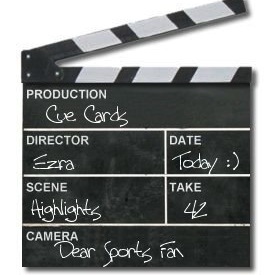
Yesterday — Tuesday, October 7
- Good bye Washington — The San Francisco Giants beat the Washington Nationals 3-2 to win game four of their series and advance to the next round. The Nationals were said to have the best five pitcher rotation in the league, and they might have, but scoring nine runs in four games was just not enough to beat the Giants.
Line: It wasn’t Washington’s pitching that mattered in the end because their hitting was so bad.
What’s Next: The Nationals clean out their lockers and go home. The Giants advance to the National League Championships (the semifinals) which begin on Saturday. - Another home run, another victory — One swing of the bat was enough to lift the St. Louis Cardinals over the Los Angeles Dodgers. Matt Adams hit a three run home run in the seventh inning and the Cardinals beat the Dodgers 3-2. The most gossip-worthy plot point of this game was the Dodgers’ manager’s decision to bench young star Yasiel Puig who had not been playing well. It’s never clear in hindsight whether it was a good move or not (the Dodgers could have lost more decisively if their manager hadn’t done that) but because sports is so results oriented, I’m sure the manager will be a much criticized man today.
Line: I don’t think I would bench my star in an elimination game no matter how poorly he was playing.
What’s Next: The Cardinals move on to play the Giants in the NLCS which starts on Saturday.
Why is the bunt controversial in baseball?
Last week we answered a great question about what bunts are in baseball. We decided to split up our answer into two parts: How does a bunt work in baseball? and Why is the bunt controversial in baseball?
Dear Sports Fan,
How does a bunt work in baseball? And why is it so controversial right now?
Thanks,
Otis
— — —
Dear Otis,
One of the best things about baseball is how long we’ve been playing it professionally in this country. The first professional league started in the 1870s. Baseball fans love that their sport has such a long professional history in this country and they keep a lot of it alive. Bunting has been alive as a strategy since the very beginning of professional baseball and it’s been controversial for one reason or another for almost the whole time! Let’s take a quick trip back in time to see how bunting and the reasons for its controversy have changed. To help as along our way, I found two wonderful articles about the history of baseball and bunting that I’m going to lean on heavily. The articles are “Why do baseball players still bunt so damn much” by Erik Malinowski for Bleacher Report and “Baseball’s long and complicated relationship with the bunt” by Randy Leonard for The Atlantic. I recommend reading both!
In the 1870s, baseball was basically an adolescent. It was played by established rules but they weren’t the rules that it would settle into in time. The two rules that we’re concerned with are the shape of the bat and the rule that determined what a foul ball was. Today, of course, bats are rounded and a foul ball is one that either falls outside of the lines that extend from home plate to the outfield or passes first or third base to the outside of the bases. In 1870, these rules were a little different. The shape of a batter’s bat was up to him and critically to the subject of bunting, a flat bat was allowed. The foul rules were different in that a ball would be called fair no matter where it landed as long as it first hit the ground in fair territory. The combination of these two rule differences made bunting a particularly effective strategy. The flat bat made it much easier to do and the fair/foul rule made it much more effective because you had far more territory open to you to direct the ball away from fielders. Bunting was so effective that in the 1870s, a bunting specialist named Ross Barnes led the league in hits and batting average more than a third of the time.
Effective as it may have been, bunters took their share of abuse. According to Leonard, fans in the 1870s “jeered that it was effeminate” and in 1904, then president, “William Howard Taft publicly scorned the bunt.” And there’s more:
In 1873 The Boston Globe called bunting “the black game,” an acknowledgment of one’s “weakness at the bat,” and a few years later the Detroit Free Press called it a “babyish performance.”
There is something that feels, even to this day, underhanded about bunting. You feel instinctively that the batter should be trying to hit the ball hard not let it bounce gently off of their bat. When a bunt doesn’t work, it feels foolish, but when it does work, it makes the defense look foolish in a way that a hard-hit line drive or even a home run does not. The bunt plays against the ultra-masculine image of sports and for that reason it can be controversial. That’s not the main reason why the bunt is controversial today.
The bunt is controversial today because it’s basically been proven to be a bad idea. Baseball has been undergoing a statistical and cultural revolution since the 1980s. Many stats that once were seen as meaningful indications of performance, like RBIs and runs, have proven to be mostly meaningless and have been replaced with better stats. The statistical reality of bunting is that even when it works, the team that does it is intentionally sacrificing an out to advance a runner. The value of doing this is negative. A team with no outs and a man on first base (a normal scenario before a bunt) has a better chance of scoring a run that inning than a team with a runner on second and one out (a normal scenario after a bunt.)
Bunts are back in the news in a big way because the Kansas City Royals have been bunting like crazy. Or, more accurately, they have been bunting like they are a team from the 1980s, as Will Leitch suggests they might be in his enjoyable Sports on Earth article:
Watching them [the Royals] play — the five sacrifice bunts, the seven stolen bases, the lack of homers and strikeouts — has me thinking that this isn’t just the first time the Royals have made the playoffs since 1985: I’m honestly concerned that this team has been beamed here from the year 1985.
And they’ve been winning. The Royals are 4-0 in this year’s playoffs and are only four wins from making it to the World Series. Are they doing this because of or in spite of their bunt-happy retro style? Dave Cameron looked into the four bunts of their wild Wild Card victory for fangraphs.com and concluded that of the four, one bunt was a mistake, one was unclear, and two were “probably positive.” Overall, Cameron writes that:
In late game situations where one run is paramount, bunting can often be the correct play, and the don’t-bunt-ever reaction can be just as incorrect as the bunt-always fanaticism.
Looking at the comments under his article, it’s clear that many readers and baseball fans don’t agree. After 140 years of baseball history, the controversy about the bunt may just be getting started.
Thanks for the question,
Ezra Fischer
Cue Cards 10-6-14
Cue Cards is a series designed to assist with the common small talk about high-profile recent sporting events that is so omnipresent in the workplace, the bar, and other social settings.
- Two baseball sweeps — The Kansas City Royals and Baltimore Orioles both won games yesterday to complete three straight out of five game sweeps of their American League division series. In case you need to check quickly, this is how the Major League baseball playoffs work. The Royals beat the Los Angeles Angels 8-3 and the Orioles beat the Detroit Tigers 2-1.
Line: I guess in this case, having the early series be a best three out of five instead of four out of seven was the right choice. Both teams won convincingly in sweeps.
What’s Next: The Royals and the Orioles get a little rest before their series starts on Friday. That’s because the four teams in the National League, the Cardinals, Dodgers, Nationals, and Giants are still playing their divisional series. The National League divisional series continue today. - An exciting day in the NFL — The NFL had its customary slate of games yesterday but they were more closely contested than most weekends. There were two overtime games and another won in the last second. All the recaps you want or need can be found in our NFL One Liners column.
Line: Football overtime isn’t as good as hockey or baseball overtime but it’s still unusual and exciting.
What’s Next: Monday night football is lined up to be a clunker. It’s a good chance to do something else!
How does a bunt work in baseball?
Dear Sports Fan,
How does a bunt work in baseball? And why is it so controversial right now?
Thanks,
Otis
— — —
Dear Otis,
A bunt is a baseball tactic where the batter hits the ball softly and directs it onto the ground. This tactic is often used as a form of sacrifice where the batter knows that she is likely to be thrown out at first base but a runner already on first, second, or less normally, third base will be able to easily advance to the next base. It’s a very old tactic and has always been controversial for one reason or another for more than a hundred years. Bunting is in the news a lot right now because the Kansas City Royals have been bunting far more than normal and have won their first two playoff games. Let’s make this a two-part post. We’ll handle how bunts work in the first half and then look into why it’s controversial in a second post.
How does a bunt work?
When a batter decides to bunt or is given instructions to bunt, she waits until the pitcher is starting to pitch and then quickly does two things: she slides her hands up the barrel of the bat and separates them for better control; as she is doing this, she pivots so that her body opens up towards the pitch. Once in bunting position, the batter does her best to make contact with the top half of the ball, so that instead of popping up for an easy out, the ball goes downwards. Advanced bunters are able to also direct the ball towards their base or first, whichever is going to be harder for the defense to field.
Getting into bunting stance does not count as a swing. A strike can only be called if, once the player is in bunting stance, they make a “movement indicating an attempt to contact the ball.” This is a wrinkle in baseball’s rules so obscure that most players and umps don’t even know this, so you will see players draw back from their bunt position if they believe the pitch is out of the strike zone and they want to ensure themselves a ball instead of a strike. A better known bunting rule is that a foul ball on a bunt attempt may count as a player’s third strike. If a batter swings at the ball and fouls it off, that can never count as a third strike, but a bunt attempt can. A foul ball is one that passes outside of first or third base. Since most bunts don’t go that far, wherever the ball stops rolling determines whether it’s fair or foul. Here’s an example of a bunt hit perfectly down the line which flummoxed the defense which was hoping it would roll foul:
If the defensive team notices that a batter is trying to bunt or thinks they might from the context of the game, they may shift where they line up in the infield to position themselves better to respond to a bunt. This usually means closer to home plate. When a bunt is made, the infielders will charge towards the rolling ball and try to get to it in time to pick it up and throw a runner out. Here’s a third baseman fielding a bunt perfectly:
As we mentioned before, a lot of bunters bunt with the intention of sacrificing themselves for the good of a runner on base. This is called a sacrifice bunt and is most often done to move a runner from first to second base. Once on second base, a runner is generally though of as in “scoring position” because they can usually make it home on any ball hit safely into the outfield. This makes it less necessary to sacrifice an out to move them to third base. A special kind of sacrifice bunt is called a squeeze play. This is when a sacrifice bunt is made to get a runner from third to home base. Sounds crazy, right? An even more daring play is the “suicide squeeze” where the runner from third starts running home before the batter even makes contact with the ball. This takes real confidence in the ability of the batter to successfully bunt the ball because if they don’t, you’ve got the catcher standing there waiting to tag the runner out. Some players use the bunt without any sense of sacrifice. They bunt because they are good at bunting and fast enough to make it a reasonable way to get safely to first base. Bunting for a base hit means that you’re basically giving up on the idea of hitting a double, triple, or home run (although doubles do sometimes happen off of bunts!) but it can still be a good strategy, especially if you can surprise the fielders by bunting when they are not in position to field the bunt.
So, that’s how a bunt works. We’ll dig into why bunts are controversial soon.
Ezra Fischer
Cue Cards 10-3-14
Cue Cards is a series designed to assist with the common small talk about high-profile recent sporting events that is so omnipresent in the workplace, the bar, and other social settings.

Yesterday — Thursday, October 2
- The Royals magic continues — The Kansas City Royals won game one of their playoff series with the Los Angeles Angels 3-2. Like their first game of the playoffs, this game went into extra innings. Mike Moustakas hit a home run in the eleventh inning to push the Royals ahead of the Angels.
Line: The Royals sure are exciting!
What’s Next: Game two is Friday night at 9:37 p.m. ET on TBS. - Beat down in Baltimore — The Baltimore Orioles beat the Detroit Tigers 12 – 3 in game one of their playoff series. Baltimore isn’t quite the feel-good story that the Royals are but they have only made the playoffs one other time since 1997, so they’re a good underdog to root for also.
Line: Detroit has such great pitchers, you don’t expect to see them lose in such a lopsided, high-scoring game.
What’s next: Game two is Friday at noon ET on TBS. - You wanna buy a duck? — The Oregon Ducks’ college football team went into last night’s game ranked number two in the country. They lost 31-24 to Arizona. This is the second straight year that Arizona has upset them. The Ducks are famous for their dynamic spread-offense and their flamboyant uniforms. The coach of Arizona’s team, Rich Rodriguez, spent many years coaching at West Virginia about ten years ago where he was one of the early adopters of the spread-offense. Perhaps he knows how to defend it better than most.
Line: Sad to see the Ducks lose so early in the season. That said, they’re the most exciting when they are looking to upset the top teams, not the other way around. - Thursday Night NFL games continue to stink — There’s so many reasons to dislike having NFL games on Thursdays. It breaks the rhythm of the weekend, it sullies fantasy games, it’s terrible for the health of the players, and it’s a unabashed money grab by the NFL, but perhaps the best argument against them is that they stink! So far this year, of the five Thursday games, the scores have been 36-16, 26-6, 56-14, 45-14, and now, 42-10 with last night’s Green Bay Packers win over the Minnesota Vikings. No fun!
Line: It’s barely even worth watching these Thursday night games. They’re over before they even get started.

